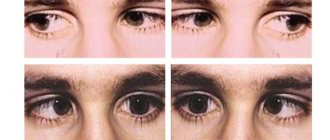A pathological condition characterized by intolerance to light is called photophobia. Occurs under the influence of both natural and artificial light. The main symptoms of the disease are: a feeling of pain in the eyes, redness, lacrimation. A person suffering from photophobia tries in every possible way to avoid the light source - squinting, covering his eyes with his hands, hiding. In darkness or twilight, the eyes return to a relatively normal state.
Also, fears of light are inherent in people suffering from heliophobia. It is important to be able to distinguish between these names. Unlike photophobia, heliophobia is a mental disorder. Its main symptom is fear of sunlight. The disease is absolutely not associated with visual impairment. It is a mental illness accompanied by an obsessive fear of being in the sun.
Main reasons
Fear of light is a fairly common phenomenon, and is not always associated with the occurrence of diseases. Very often, increased sensitivity occurs in healthy people after a long stay in a room that is poorly lit or after a long stay in the open sun without sunglasses.
A phobia can develop as a result of prolonged work at the computer or prolonged viewing of TV. The phobia often occurs as a result of prolonged wearing of lenses or improper selection of lenses. Wearing the wrong glasses can also cause fear of bright light.
Quite often, photophobia occurs due to the use of atropine-like drugs. After stopping the medication, the condition returns to normal.
If there is insufficient pigment or no pigment at all, a congenital phobia arises. Because people with light-colored eyes are more at risk of photophobia.
A phobia of light can be a sign of the following diseases:
- injuries, foreign bodies in the eyes;
- eye burns;
- glaucoma (most often with increased eye pressure);
- inflammation of the cornea;
- inflammation of conjunctivitis;
- inflammation, partial or complete absence of the iris;
- albinism;
- mesh separation;
- damage to the oculomotor nerve or its branches;
- eye tumors.
A phobia of light can develop as a result of surgical operations.
Fear of light - Gunther's disease
A very rare condition (one in a million cases) involves increased sensitivity to light. This is Gunther's disease or erythropoietic porphyria. The disease is hereditary: the child receives the altered gene from both carrier parents. Families in which the husband and wife are blood relatives are at particular risk.
Key symptoms of pathology:
- Skin photosensitivity.
- A large amount of body hair (hypertrichosis).
- Red color of urine.
- Discoloration of teeth to red-brown.
- Increased size of the spleen and liver.
- Hemolytic anemia.
- Ulcers and inflammations on the nose, cartilage, eyelids, ears.
Gunther's disease is diagnosed in early childhood. There is no effective treatment, and the prognosis is poor: as a rule, the patient dies before reaching adolescence.
Patients are forced to avoid sunlight, hide their skin under clothing as much as possible, and use photoprotective agents. The windows are covered with ultraviolet-reflecting film, and only incandescent lamps are used to illuminate the house. Nevertheless, the patient’s appearance is still gradually disfigured.
Other factors
The causes of photophobia can also be due to other diseases:
- Migraine. The disease is based on the trigeminal nerve. Its main symptoms are: severe headache, photophobia, and sound sensitivity.
- Stroke. The main causes of occurrence: disruption of the blood supply to a certain part of the brain, as a result of blockage of the supply vessel or squeezing it with a hematoma. With hemorrhagic stroke, fear of light often occurs.
- Various infectious diseases, for example: encephalitis, meningitis, rabies.
- Encephalitis is an inflammatory disease of the brain caused by parasites, germs or toxins. Its main symptoms are headache and impaired consciousness. Fear of light is formed as a result of irritation of the membranes.
- Meningitis is an inflammatory process of the meninges. The cause is the entry of bacteria into the human body. Also one of the accompanying symptoms is photophobia.
- Rabies is a severe viral disease. It occurs as a result of the saliva of a sick animal entering the body. Symptoms of rabies: excessive secretion of saliva and sweat, fear of water, air, sound and light.
- Other brain diseases - abscesses, tumors. In addition to headache, intoxication and focal symptoms, brain swelling or irritation of the membranes is accompanied by a fear of light.
What diseases does photophobia of the eyes indicate: symptoms, causes and effective treatment
Photophobia of the eyes (photophobia) is a violation of the functionality of the visual organ; its causes are often encountered in everyday life. Behind the outward harmlessness lies constant discomfort and painful sensations in the eye area caused by exposure to light.
What is photophobia?
Fear of light in a person with normal vision is present without pathological reasons. Individual sensitivity to light intensity means that one eye can handle high intensity while the other is designed to handle lower intensity.
Each symptom of photophobia is the result of a violation of certain interrelated processes. A failure that occurs at a certain stage interferes with the natural regulation of pupil size, and it is this action that determines the ability of the human eye to perceive different levels of illumination. Possible associated symptoms:
- Headache due to photophobia is a characteristic symptom caused by a malfunction of the optic nerve, the oculomotor nerve.
- Eye pain is a consequence of dysfunction of the nervous tissue, failure of its conductivity. These symptoms may develop from local lesions or result from other diseases.
- The fact that fear of light is accompanied by lacrimation is a typical manifestation in many eye pathologies, a common and uncharacteristic symptom.
- The presence of a functional disorder of the eyes can be determined by other uncharacteristic signs - redness of the sclera, nausea, vomiting, and sometimes dizziness and migraines.
- Impaired concentration of attention, decreased ability to perform habitual actions - all this indicates not so much the presence of photophobia of the eyes itself, but rather the presence of a cause that causes hypersensitivity of the organ of vision.
Establishing a reliable reason that triggers the development of an unfavorable scenario is the real way to achieve a cure. Only eliminating the provoking factor will help get rid of the negative state.
Causes of the disease
The main causes of photophobia are considered to be diseases of the organ of vision. Conjunctivitis, mucosal ulceration, glaucoma, keratitis or neoplasms are equally likely to lead to the development of symptoms in an adult.
However, photophobia also occurs with a cold, a viral infection of the body, nervous stress, overwork, disturbances in normal sleep or permanent lack of sleep. Retinal detachment, exacerbation of glaucoma, or eye injury can cause approximately similar symptoms.
Therefore, ophthalmologists recommend being examined by other specialists. The list of diseases under which photophobia develops is quite extensive. In different cases, the reason may be:
- pathologies of the nervous system;
- infectious and viral diseases;
- congenital anomalies of the structure of the organ of vision or albinism;
- brain injuries;
- constant strain on the visual organs during professional activities;
- taking or using certain medications;
- adherence to bad habits;
- oncological processes;
- trauma, microtrauma of the cornea from mechanical or chemical damage.
Modern ophthalmology notes an increase in the prevalence of negative symptoms caused by more dangerous conditions (encephalopathies, epilepsy, cerebral edema due to systemic disorders in the body), as well as seemingly harmless ones, such as constantly visiting a solarium, sitting at a computer, working outside on a sunny day .
Causes in children
When photophobia develops in children, the causes are often found in incorrect selection of optics, congenital developmental anomalies, and insufficient amounts of melanin. More common reasons for the development of photophobia in childhood are frequent colds and past viral and infectious diseases.
There is another rare pathology of autoimmune failure, called pink disease, in which photophobia develops. The pathology received this name because of the characteristic pink discoloration of the feet and palms. This failure of the immune system has other symptoms, such as high blood pressure and anorexia, hyperhidrosis, by which it is easier to diagnose than by the presence of photophobia of the eyes.
Diagnostics
Photophobia of the eyes is diagnosed after a visual examination, the use of a triad of studies: traditional ophthalmoscopy, scraping from the cornea and studying the condition of the fundus vascular system.
If suspicions arise or differential diagnosis of the visual organ is necessary, a referral to a specialized specialist is given. He prescribes laboratory tests, MRI, CT, ultrasound and other types of hardware studies.
Treatment of fear of light
Treatment tactics for photophobia of the eyes are determined only after a reliable diagnosis has been made. Therapy is aimed at eliminating the provoking factor.
Drug treatment is used for bacterial or fungal infections or acute chronic diseases that have caused the development of a functional failure.
In this case, the following drugs are prescribed:
- "Okomistin";
- "Tobradex".
Glasses for photophobia are prescribed by an ophthalmologist as a temporary or preventive measure.
Prevention
Susceptibility to injury and illness can cause any eye disease. The best preventative measures are to take good care of your eyes and regularly see an ophthalmologist for examination.
Source: https://ozrenieglaz.ru/simptomy/svetoboyazn-glaz-prichiny
Symptoms
A person with photophobia experiences severe discomfort when exposed to any light. Regardless of whether it is natural or artificial. The person cannot look at the light, feels pain, burning, and lacrimation. Also, in addition to the main symptoms, the disease may be accompanied by a headache.
In some cases, people with photophobia cannot tolerate bright light, while others cannot tolerate any light at all. It is important to distinguish the fear of light from the usual reaction of the eyes to too bright light. The manifestation of the disease begins from exposure to ordinary brightness, for example a 60 W lamp on a surface.
If any of the above symptoms occur, you should consult a doctor.
Treatment of heliophobia
Fear of light requires a serious examination and an accurate diagnosis. If the presence of delusional ideas is detected, then we can talk about schizophrenia.
At the initial stage of treatment for heliophobia, the patient really needs support from loved ones, since constant daytime walks with relatives or friends may be recommended as a treatment method. This is how a gradual adaptation to the object of fear occurs, that is, to the sun.
In the treatment of heliophobia, methods of cognitive behavioral therapy, neurolinguistic programming and auto-training are effective.
If the patient has health problems caused by a lack of sun exposure, appropriate drug treatment is prescribed.
The following precautions will help reduce anxiety and reduce the risk of negative effects of ultraviolet rays on the body:
- You should go for a walk during the hours of least sun activity (before 10.00 am and after 4.00 pm).
- In clear weather, it is advisable to wear sunglasses and a hat (scarf, cap, Panama hat).
- Before leaving the house, you can apply a protective cream to your skin.
- You should wear light-colored clothing or clothing made from UV-resistant fabric.
- You should always have drinking water with you.
Diagnostics
Fundus examination is necessary to make a diagnosis. This examination is carried out in a special lamp. The condition of the vitreous body is checked. The fields and angle of the eye are also checked, corneal thickness and eye pressure are measured.
Transparent media are examined using ultrasound diagnostics. Using fluorescein angiography, vascular patency is examined. Using tomography, it is determined whether there are any changes in the retinal tissue. The electroretinography method helps to study the functioning of the retina in detail. Sowing from the conjunctival sac is also performed.
If the examination did not reveal ophthalmological causes, additional examinations are necessary: magnetic resonance imaging of the brain, examination of the vessels of the neck, electrocephalography, X-ray of the lungs, ultrasound diagnosis of the thyroid gland. If concerns are confirmed, the help of an endocrinologist, neurologist, or phthisiatrician may be required.












